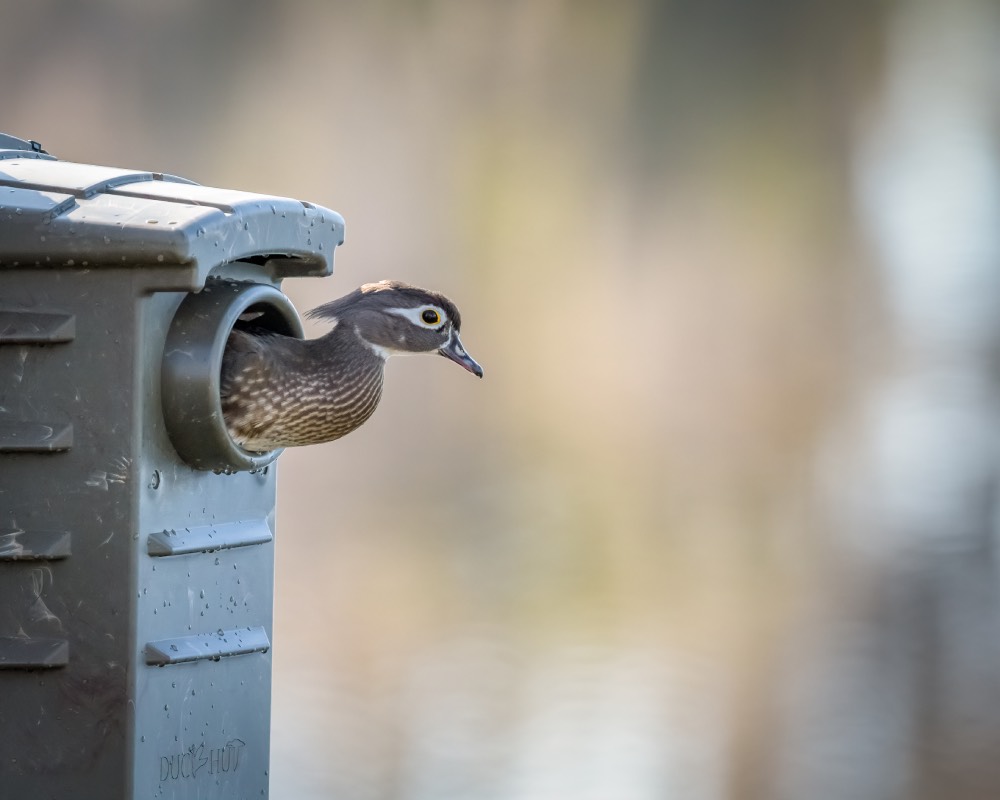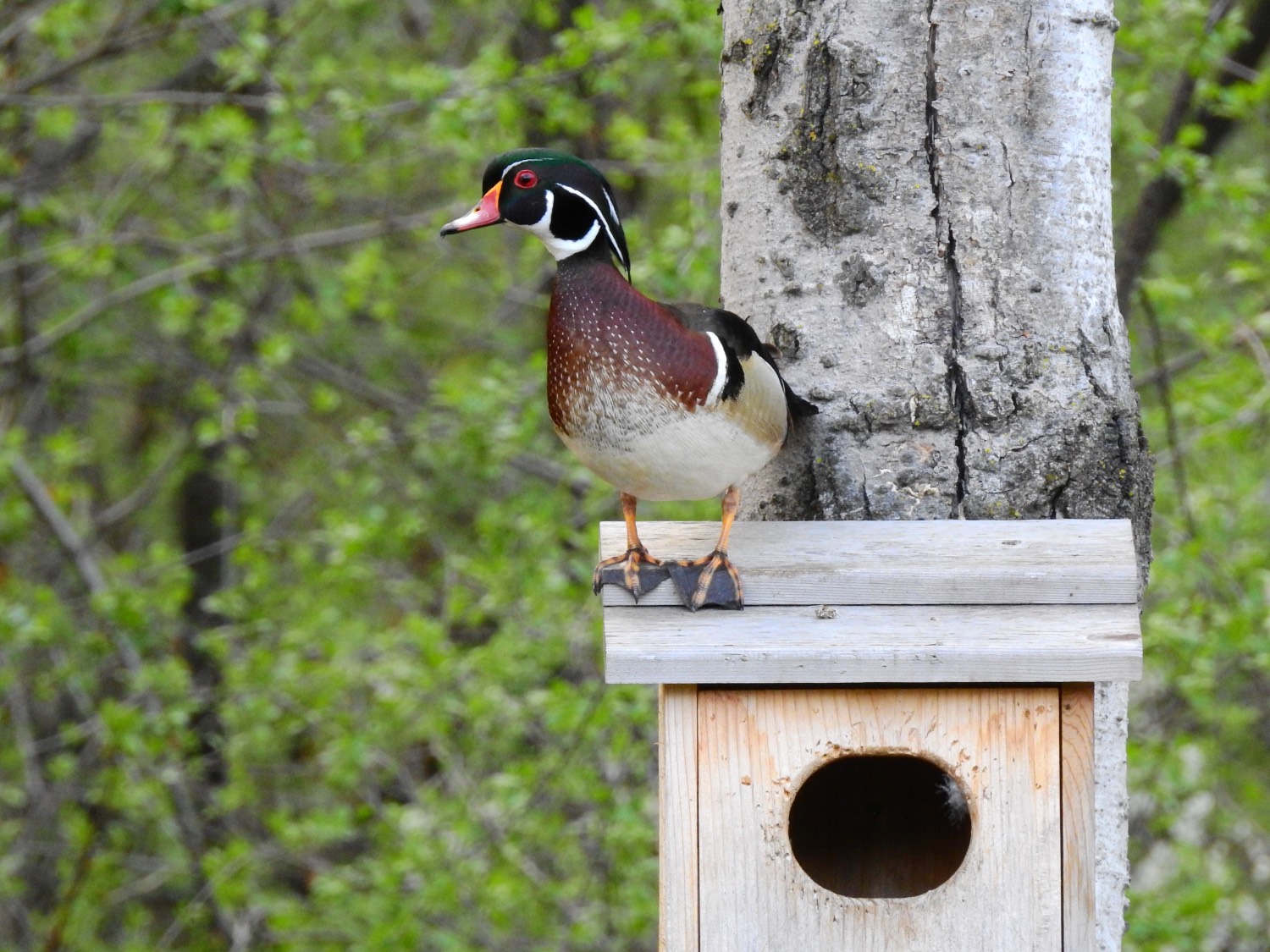
Blake Hamilton, Wildlife Biologist and Registered Forester
With the increase of urbanization and short-term timber harvesting, wood duck nesting habitat is decreasing. Most timber stands are currently managed for the quickest return possible. Therefore, old growth and mature hardwoods, which provided cavities for wood duck nesting, are decreasing. So what can we do about this decline? Install wood duck boxes!
With the proper design and layout, man-made wood duck nesting structures can be a key asset to help preserve and enhance wood duck populations and habitat. Wildlife requires three key elements for survival: food, cover, and water. If a habitat is missing any of these pieces, the puzzle isn’t complete. A proper box provides cover to ensure shelter and protection for eggs and ducklings when they are most vulnerable. However, simply nailing a wood duck box to any random tree near your pond may do more harm than good. Knowledge of nesting methods, strategic placement and design of the box is imperative if you’re interested in seeing results from your labors.
A quality box consists of 4 key features: design, protection, location, and maintenance. Let’s take a more detailed look at each feature.
Wood Duck Box Design
A quality box first needs to be durable and built to last. Cypress is a great wood material that can withstand long-term weather conditions. You do not want the wood to be treated because it can be poisonous to avian species. The dimensions of the box should be large enough to hold 12 to 15 clutch eggs and hen. There should be an entry/exit hole large enough for the hen to have easy access, yet not too large for unwanted avian species to enter. All hardware (hinges, screws, latches) should be rust-proof. A door should be located on the side with a gap at the top to help with ventilation. The door is a must for yearly maintenance, which we will discuss later. Small holes or gaps in the corners of the floor will help with drainage.
Protecting Wood Ducks From Predators
A quality box is useless without the insurance of protection from predators. One method of protection is provided by a predator guard or shield. The guard is cone shaped with at least a 24-inch base and the top should seal tightly to the post. The wide base prevents raccoons from climbing the post and robbing the nest. The sealed top of the cone prevents predation from snake species. Overhanging branches should also be removed to discourage raccoons and other arboreal predators access to the nest. A durable post will serve as a mount for the box and guard, as well as anchor to keep the box in place. The post should be tall enough to keep the guard and box above future vegetation growth and water levels.

Photo by Kevin Thurk
Best Location for Wood Duck Boxes
The location chosen to install the box is very important. Installation can be performed annually, but nesting season occurs February through June. Boxes can be installed in wetlands, swamps, creeks, ponds, oxbows, or lakes. Placing boxes in a wooded landscape will provide a natural setting. The box needs to be facing open water and at least 4-6 feet above the water line to avoid possible flooding. The water marks on the native trees will serve as a good indicator of future water depth. If the water is too deep, largemouth bass will attack and consume ducklings once they emerge from the box. A slight forward tilt can help with drainage, prevent precipitation buildup, and reduce stress from wind and rain during the nesting period. Wood ducks will perform what is called “dumping,” if boxes are installed too close together, especially in highly visible areas. This occurs when hen wood ducks “dump” their eggs in multiple boxes, rather than staying consistent using one box, triggered by viewing another hen using that box. This dumping effect can overload a box; therefore, a hen cannot incubate the added eggs, which can lead to a reduction in hatch success or an abandoned box. A good rule of thumb is to give boxes a 100-foot spacing for prevention of "dumping."
Maintaining Wood Duck Boxes
A little maintenance is required in order to ensure the quality of the boxes and that they stay productive. Cavity nesters do not deliver nesting materials to the nesting site. They use material currently found within the natural cavities such as: bark strips, debris, and decayed wood materials. There should be a 3 to 4-inch layer of wood shavings or sawdust covering the bottom of the box, providing cushion for the eggs and heat retention during incubation. This layer will protect the eggs and help hold warmth during incubation. This mimicked nesting material should be replaced at the beginning of the nesting period each year. Like all wildlife species, it is important to limit disturbances, especially during the nesting period.
Every piece of the puzzle must be performed and fitted properly to ensure an acceptable degree of success. With the proper design, protection, location, and maintenance, wood duck boxes can contribute to the preservation and enhancement of wood duck populations and habitat.
To buy a Duck Hut wood duck box, visit their site.




























